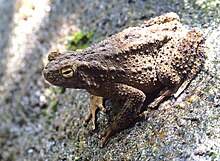Phrynoidis asper
Appearance
| Phrynoidis asper | |
|---|---|

| |
| An Asian giant toad from Nakhon Si Thammarat, Thailand | |
| Scientific classification | |
| Domain: | Eukaryota |
| Kingdom: | Animalia |
| Phylum: | Chordata |
| Class: | Amphibia |
| Order: | Anura |
| Family: | Bufonidae |
| Genus: | Phrynoidis |
| Species: | P. asper
|
| Binomial name | |
| Phrynoidis asper (Gravenhorst, 1829)
| |
| Synonyms | |
|
Bufo asper Gravenhorst, 1829 | |
The Asian giant toad (Phrynoidis asper), sometimes referred to as the river toad, is a species of true toad native to Mainland Southeast Asia and the Greater Sundas.[2] It is a medium-large toad, but it is easily confused with its larger relative, the giant river toad (P. juxtasper).[3]
Description
Phrynoidis asper is generally a dark grey, green, black or brown in color, and is heavily covered in tubercles. Females can reach up to 14 cm (5.5 in) in snout–to–vent length and males up to 10 cm (3.9 in). They can be commonly found near stream and rivers.[4]
References
- ^ Robert Inger; Djoko Iskandar; Peter Paul van Dijk (2004). "Phrynoidis asper". IUCN Red List of Threatened Species. 2004. Retrieved 5 June 2013.
{{cite journal}}: Invalid|ref=harv(help) - ^ Frost, Darrel R. (2015). "Phrynoidis asper (Gravenhorst, 1829)". Amphibian Species of the World: an Online Reference. Version 6.0. American Museum of Natural History. Retrieved 29 September 2015.
- ^ Haas, A.; Hertwig, S.T.; Das, I. (2020). "Phrynoidis juxtasper (Giant River Toad)". Frogs of Borneo. Retrieved 26 January 2020.
{{cite web}}: Unknown parameter|last-author-amp=ignored (|name-list-style=suggested) (help) - ^ "Phrynoidis aspera". AmphibiaWeb: Information on amphibian biology and conservation. [web application]. Berkeley, California: AmphibiaWeb. 2014. Retrieved 24 January 2020.
- "Bufo asper". Integrated Taxonomic Information System. Retrieved 19 March 2006.
- Frogs of the Malay Peninsula: Bufo asper

